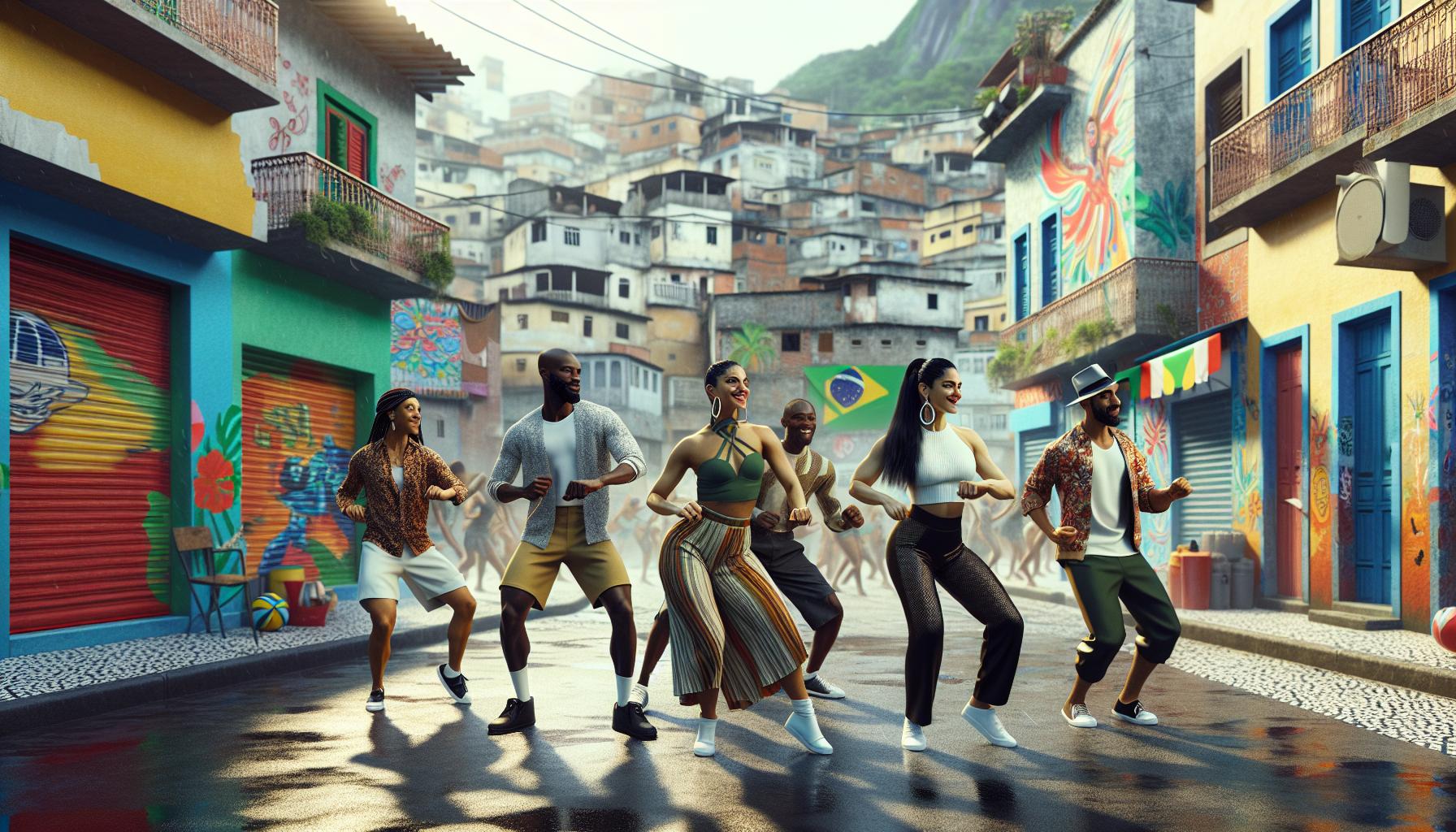In the vibrant landscape of Brazilian culture, “pornocaríoca” stands out as a unique fusion of eroticism and local identity. This genre, which emerged from Rio de Janeiro, reflects the city’s dynamic spirit, intertwining elements of its lively favelas and rich artistic heritage. It’s not just about adult entertainment; it’s a cultural phenomenon that challenges societal norms and provokes conversation.
As it gains popularity, pornocaríoca captivates audiences both within Brazil and beyond, showcasing the raw energy and creativity of its performers. By blending provocative themes with authentic storytelling, this genre offers a glimpse into the complexities of urban life in Rio. Understanding pornocaríoca provides insight into the evolving landscape of entertainment and the cultural dialogues it inspires.
Pornocaríoca
Pornocaríoca is a unique adult entertainment genre that blends eroticism with aspects of Brazilian culture, particularly that of Rio de Janeiro. This genre showcases the vibrant life and traditions of the city, drawing inspiration from its favelas and rich artistic legacy. Pornocaríoca transcends traditional adult content, acting as a cultural expression that engages with and critiques societal norms.
This genre features various elements, including:
- Cultural Roots: Integrates music, dance, and visual art from local traditions.
- Artistic Expression: Highlights creativity and individuality of performers, reflecting the spirit of Rio.
- Social Commentary: Challenges preconceptions about sexuality and class through provocative narratives.
As pornocaríoca gains popularity both domestically and internationally, it offers a lens into the complexities of urban life in Rio de Janeiro. This genre promotes discussions surrounding cultural identity, making it a significant topic in contemporary entertainment and studies related to societal dynamics.
History of Pornocaríoca

Pornocaríoca has a rich history rooted in the cultural dynamics of Rio de Janeiro. This genre reflects localized expressions of sexuality, art, and social commentary.
Origins and Evolution
Pornocaríoca emerged in the late 20th century as part of Brazil’s broader cultural landscape. The late 1980s marked a pivotal period, where Brazilian cinema began exploring more explicit themes and narratives. This era coincided with the country’s transition to democracy, fostering openness toward diverse expressions of sexuality. Local filmmakers and performers utilized elements of samba, bossa nova, and funk carioca, infusing storytelling with vibrant cultural motifs. Over time, pornocaríoca evolved from niche underground productions to a more mainstream presence, illustrating the genre’s adaptability and resonance within Brazilian society.
Key Milestones
Significant milestones punctuate the history of pornocaríoca, shaping its growth and recognition:
- 1980s Cultural Shifts: The relaxation of censorship laws in Brazil allowed for explicit content in films and performances, introducing broader narratives on sexuality.
- Rise of Independent Filmmakers: Independent projects began showcasing bold depictions of eroticism combined with samba rhythms, earning recognition in local festivals.
- Internet Expansion in 2000s: The advent of online platforms facilitated greater accessibility to pornocaríoca content, broadening its audience beyond Rio de Janeiro.
- Globalization of Brazilian Culture: Increased international interest in Brazilian music and dance elevated the profile of pornocaríoca, allowing it to enter global discussions on sexuality and cultural identity.
- Artistic Collaborations: Collaborations with established visual artists and musicians further legitimized pornocaríoca as a significant cultural movement, emphasizing its artistic merit.
These key milestones underline pornocaríoca’s journey as it continues to engage audiences and influence cultural discourses on sexuality and identity.
Cultural Impact

Pornocaríoca significantly influences Brazilian society and culture, fostering dialogue around sexuality, class, and identity. Through its provocative nature, it reflects and challenges societal norms, prompting discussions that resonate deeply within urban contexts.
Influence on Brazilian Society
Influence manifests in several ways, including the portrayal of marginalized communities. Pornocaríoca highlights the realities of life in favelas, offering a platform for authentic representation of those often overlooked. Performers, through their narratives, break taboos related to sexuality and promote acceptance of diverse sexual orientations.
Additionally, pornocaríoca contributes to the national conversation about body positivity and empowerment. By featuring various body types and promoting confidence among performers, the genre encourages a more inclusive standard of beauty, impacting societal perceptions and attitudes toward physical appearance.
Reception by the Global Audience
Reception varies among global audiences, drawing intrigue and curiosity. Many viewers appreciate the genre’s artistic aspects, recognizing it as a form of cultural expression rooted in Brazilian identity. This recognition fosters a broader understanding of Brazilian culture beyond traditional stereotypes associated with adult entertainment.
Critics, however, often confront the genre due to its explicit content and themes. Despite criticism, pornocaríoca continues to attract international attention, contributing to the growing interest in global cinema that challenges conventional norms. As the genre evolves, it positions itself as a relevant cultural phenomenon on the world stage.
Characteristics of Pornocaríoca

Pornocaríoca stands out for its unique blend of eroticism and cultural storytelling, reflecting the spirit of Rio de Janeiro. This genre incorporates various themes and innovative production techniques, making it a significant cultural expression.
Themes and Genres
Pornocaríoca weaves together a range of themes, including:
- Social Identity: It explores issues of class, race, and gender while depicting the realities of life in favelas.
- Desire and Pleasure: The genre emphasizes eroticism, celebrating sexuality and diverse sexual orientations.
- Cultural Narratives: It integrates Brazilian folklore and modern urban culture, often portraying local traditions and contemporary life.
- Provocation: The stories challenge conventional norms surrounding sexuality, sparking discussions about morality and attention to societal taboos.
These themes enable pornocaríoca to function as both entertainment and social commentary, creating a layered viewing experience.
Production Techniques
The production techniques of pornocaríoca contribute significantly to its distinctive identity, including:
- Cinematography: Filmmakers often employ vibrant colors and dynamic camera movements, capturing the energy of Rio de Janeiro.
- Soundtrack Integration: The use of local music genres like samba and funk enhances the cultural authenticity, immersing audiences in the setting.
- Creative Storytelling: Bending traditional narrative structures, many films utilize non-linear storytelling and experimental formats to engage viewers.
- Artistic Expression: Performers incorporate elements of dance and visual art, enriching the experience and highlighting their creativity.
These production techniques help establish pornocaríoca as a vital artistic medium, reflective of its cultural roots and contemporary relevance.
Notable Works and Figures
Notable works and figures have significantly shaped the pornocaríoca genre, demonstrating its intricate ties to Brazilian culture. These films and their creators highlight the genre’s artistic merit and cultural commentary.
Iconic Films
Several films exemplify the essence of pornocaríoca, showcasing its blend of eroticism and cultural narratives.
- “Coração das Trevas” (Heart of Darkness): This film intertwines themes of desire with social commentary, set against the backdrop of Rio’s favelas.
- “A Revolução é uma Folha de Papel” (The Revolution Is a Sheet of Paper): This work explores the intersection of sexuality and political identity, providing a provocative narrative.
- “Faísca” (Spark): Known for its vibrant cinematography and energetic performances, “Faísca” highlights the vitality of Rio’s street culture.
- “Vidas em Jogo” (Lives at Stake): This film addresses issues of love and loss within marginalized communities, portraying the complexities of urban life.
These films not only entertain but also provoke thought, serving as cultural artifacts that reflect societal issues.
Influential Directors and Actors
Key figures in the pornocaríoca genre have pushed boundaries and redefined cultural representation.
- Beto Brant: Renowned for his innovative storytelling, Brant emphasizes social issues through a cinematic lens, establishing a strong narrative voice in pornocaríoca.
- Ana Carolina: As a pioneering director, Carolina’s films challenge gender norms and explore female sexuality, enriching the genre’s perspectives.
- Rafael Primot: This actor’s performances often capture the emotional depth of characters, contributing to the genre’s authenticity and relatability.
- Maya Dagu: Known for her bold portrayals, Dagu brings a unique energy that resonates with audiences, maintaining cultural relevance in contemporary works.
These directors and actors not only enhance the genre’s visibility but also advocate for diverse narratives within pornocaríoca.
Pornocaríoca stands as a bold testament to the intersection of culture and sexuality in Brazil. It not only entertains but also stimulates critical conversations about identity and societal norms. This genre captures the essence of Rio de Janeiro’s vibrant spirit while challenging traditional views on eroticism and class.
As it continues to evolve and gain international recognition, pornocaríoca highlights the importance of cultural representation in media. Its unique storytelling and artistic expression pave the way for a more inclusive dialogue around sexuality and empowerment. In embracing its roots, pornocaríoca invites audiences to appreciate the complexities of urban life and the rich narratives that emerge from Brazil’s diverse communities.
